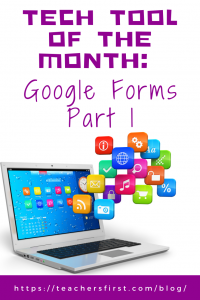Google Forms offers easy-to-use templates for creating polls, quick quizzes, signups, and forms for collecting emails or other information. Google Forms offers a quick way to assess students’ learning and is a great option for both the traditional classroom and remote learning. Teachers can choose to include various answer types, including multiple choice, short answer, and check boxes. You can also set questions to be required or optional. Google Forms even allows you to add images and YouTube videos directly into the form, which is a great option for younger learners and visual learners. Once students submit their responses, the replies are saved in real time and can be viewed by clicking the Responses tab or by clicking the link to view a Google Sheets spreadsheet.
Applying the Triple E Framework
The Triple E Framework, created by Dr. Liz Kolb, is built on the belief that “effective technology integration begins with good instructional strategies and not fancy tools” (tripleeframework.com). Dr. Kolb wrote a book on the topic, Learning First, Technology Second (ISTE, 2017), that lays out the three main uses for technology in education: to Engage, Enhance, or Extend learning goals. We can use this framework to decipher why we are using specific tools in the classroom. Here is a rubric based on the Triple E Framework you can use to evaluate whether Google Forms (or any other technology) is a good fit with your learning goals and whether you should use Forms in your lesson.

- Engage in learning goals: When using Google Forms, students are more focused on the task because there are no extra distractions or advertisements to divert their attention from the assessment and questions on the form. The students become active learners by participating in the assessment and answering the questions (or view the videos) rather than passively reading the content.
- Enhance learning goals: This tool enhances learning goals by allowing teachers to scaffold and assess the information into smaller, easier-to-digest chunks so that students can progress at their own pace. Google Forms allows students to use technology to make connections that help them understand concepts and ideas using videos, images, and other elements embedded in the form. Activities are not isolated in workbooks or stand-alone—they are connected and weaved throughout the form. All of these features enhance learning and offer a more sophisticated learning experience and an assessment with deeper connections to the topics.
- Extend learning goals: Dr. Kolb describes extended learning as an opportunity for students to learn, connect, and collaborate outside of the regular school day and as a bridge between the school day and real-life experiences. Completing Google Forms assessments outside of the classroom would work well with flipped, blended, and remote learning. Depending on the specific activities that you are doing, students could also work collaboratively outside of the school day. If you’re in class, students could work collaboratively or independently. Working in small groups may be a practical choice, as fewer devices would be required and students could work together through the various steps of the assigned activities and assessment. Google Forms activities and assessments will help prepare students for learning beyond the classroom, as they will likely need to use digital tools and follow a designed plan in their future employment, education, and personal life.
SAMR Connection
The SAMR Model, by Dr. Ruben Puentedura, suggests that technology implementation has four levels. We can use this model as a guideline to analyze how we’re using technology tools in the classroom. Google Forms is at the level of Augmentation.
- Augmentation: At this level, the technology acts as a direct substitute for a tool but provides functional improvement. The assessment and activity options provided by Google Forms are at the augmentation level because images, videos, clickable links, and more can be added. Another functional improvement is the ability to re-watch or pause included videos to deepen understanding. These clickable options could not be done using a regular textbook or without technology.
Don’t miss Part 2 of the Tech Tool of the Month: Google Forms, where we’ll discuss how to use the tool and introduce ways to use it in the classroom. In the meantime, let us know in the comment section below how you have used Google Forms in your education setting!


One thought on “Tech Tool of the Month: Google Forms – Part 1”